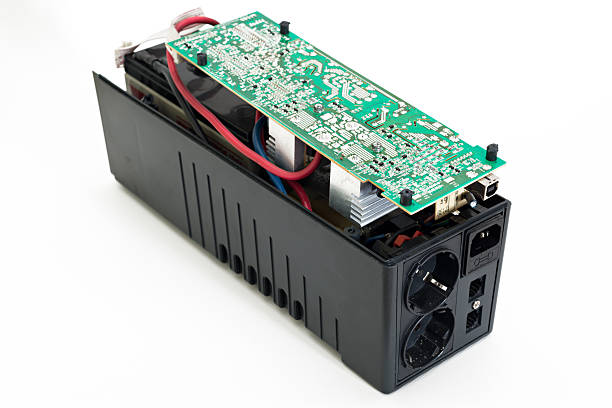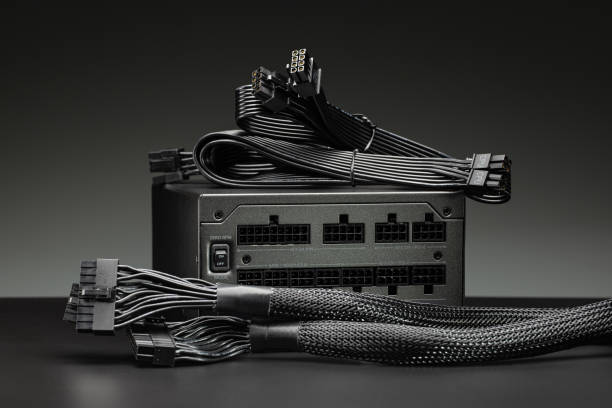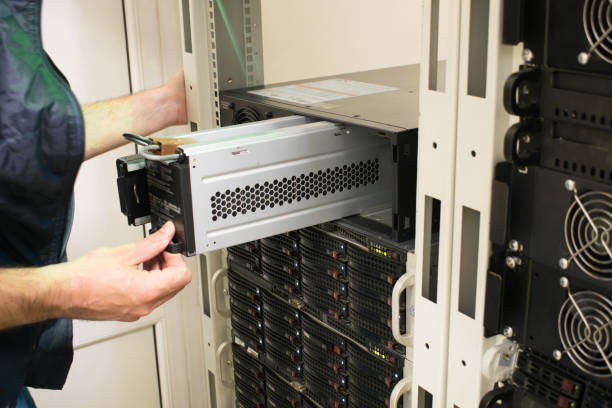Power supply efficiency is a critical factor in the operation of any electrical system. It requires careful evaluation, optimization, measurement, and maintenance to ensure a reliable and efficient power system.
Understanding the basics of power efficiency and evaluating the existing power supply system are essential components of the power efficiency process. Optimizing the power supply requires the utilization of renewable sources of energy and smart grid technologies.
Measuring the efficiency of the power supply is a key component of the optimization process, as well as proper maintenance and monitoring. Through these processes, the efficiency of power supply can be improved and sustained.
- Efficient power supply is ensured through proper maintenance and monitoring.
- It minimizes associated costs and environmental impact.
- It optimizes system performance and efficiency.
- It supports reliable power supply and enhances consumer satisfaction.
![]()
Power efficiency is an increasingly important factor in the design of modern power supply systems, as it affects the amount of energy that can be used in an efficient manner. The overall aim is to maximize the amount of energy used while minimizing energy wastage and cost.
In order to understand the basics of power efficiency, it is important to consider the types of losses that occur in a system, such as resistive losses, core losses, and switching losses. Resistive losses occur when current flows through a resistor, while core losses occur when the magnetic field is created and dissipated through the power supply. Switching losses occur when the power supply is switched on or off. All of these losses contribute to the overall efficiency of the system.
In order to improve the efficiency of a power supply, it is important to reduce the losses that occur in the system. This can be done by using proper insulation and grounding techniques, as well as by using efficient components such as transformers and switching devices. Additionally, the use of energy-saving technologies, such as solar and wind power, can help to reduce the amount of energy used and can result in cost savings over time.
The use of power efficiency is a key factor in the design of modern power supply systems. By reducing the amount of energy lost and using energy-saving technologies, it is possible to use energy in an efficient manner and to save on costs. Furthermore, by understanding the types of losses that occur in a system, it is possible to design systems that are more efficient and that can help to reduce energy wastage.

Evaluating the current power system requires an objective assessment of its capabilities to ensure optimal operations. Effective assessment involves measuring the system's ability to reduce energy costs, operate efficiently, and store energy for future use. A cost-benefit analysis should be conducted to determine the cost of operating the system in comparison to the benefits that it provides. This analysis should consider the cost of energy inputs, the cost of energy storage, the cost of equipment maintenance, and the cost of energy output.
To ensure optimal operation, the power system should also be evaluated according to its energy storage capabilities. This evaluation should include an analysis of the system's ability to store energy over extended periods of time and its ability to store energy from multiple sources. It should also consider the system's ability to efficiently release stored energy when needed. Additionally, the evaluation should consider the system's ability to conserve energy and its ability to quickly respond to changes in demand.
Finally, the evaluation should assess the system's ability to maintain its operational efficiency over time. This should include an analysis of the system's ability to maintain its equipment, the system's ability to maintain its energy output, and the system's ability to maintain its energy efficiency. This assessment should also consider the system's ability to adjust to changes in energy sources and the system's ability to adjust to changes in demand.
By conducting an objective assessment of the current power system, it is possible to identify areas of improvement and ensure that the system is operating at its highest efficiency.
Optimizing the power supply system requires a comprehensive approach to ensure maximum performance. This involves assessing the existing power supply system and identifying areas for improvement, such as cost savings, energy storage, and operational efficiency. To achieve this, the system must be evaluated to determine the current usage and capacity, and then adjusted to meet the desired energy needs.
| Cost Savings | Energy Storage |
| Solar Panels | Batteries |
| Wind Turbines | Fuel Cells |
| Geothermal | Hydropower |
The optimization process involves analyzing the power supply system and determining where improvements can be made to increase efficiency. This includes evaluating the current usage and capacity, and then adjusting the system to meet the desired energy demands. Additionally, the system must be monitored to ensure that it is operating at peak efficiency.
In addition, energy storage technologies, such as batteries and fuel cells, can be used to store excess energy for later use. This helps to reduce overall energy costs and ensure that the power supply system is always providing enough energy to meet the demand.
Finally, cost savings can be achieved through the use of renewable energy sources, such as solar and wind. These technologies can help reduce the overall cost of the power supply system, while also providing a clean and sustainable source of energy.
By taking a comprehensive approach to optimizing the power supply system, it is possible to achieve increased efficiency, reduced costs, and reliable energy supply. With these goals in mind, the system can be optimized to meet the current and future energy demands.
Measuring the performance of the power system is essential in order to identify areas where improvements can be made. For example, a case study in the Netherlands found that installing a combined heat and power system reduced electricity costs by up to 40%, demonstrating the potential for significant savings when the system is optimized.
By measuring the efficiency of the power supply, it can be determined if certain components are inefficient and require replacement or upgrades. Additionally, it can be ascertained if the power system is operating at peak efficiency. This is especially important for power systems that are connected to the grid, as reducing energy waste is essential for energy conservation.
The efficiency of the power supply can be measured using various techniques, such as measuring the input and output voltages and currents, as well as determining the power factor. Additionally, power measurement devices such as wattmeters and energy meters can be used to measure the energy consumption and power output of the system.
By employing these techniques, it is possible to identify areas of inefficiency in the power system, and make necessary changes to improve the cost savings and energy conservation.

The implementation of renewable sources of energy is essential for reducing the environmental impact of energy production and improving energy security. Renewable sources of energy, such as solar, wind, and hydropower, offer clean, sustainable energy that does not rely on fossil fuels such as coal and oil.
However, the cost of implementing renewable energy sources is high and there is often a lack of available energy storage solutions. Therefore, a cost-benefit analysis must be conducted to determine if the financial and environmental benefits of renewable energy sources outweigh the costs.
Furthermore, energy storage solutions are also necessary for the successful implementation of renewable energy sources. Various energy storage solutions, such as batteries, flow batteries, and pumped-storage hydropower, offer the potential to store energy until it is needed. This allows renewable energy sources to be used even when the sun is not shining or the wind is not blowing. Additionally, energy storage solutions can help to ensure that the power grid is stable and reliable.
In order to ensure that renewable energy sources are successfully implemented, it is important to consider the economic and environmental benefits of these sources. It is also important to invest in energy storage solutions that can help to make renewable energy sources more effective and efficient. By doing so, renewable energy sources can be used to help reduce the environmental impact of energy production and improve energy security.
Utilizing smart grid technologies can provide numerous benefits such as improved reliability, reduced costs, and increased flexibility. Smart grids enable the two-way flow of electricity and information between utilities and consumers. This enables the integration of renewable energy sources and allows for:
- Smart Charging: Utilizing smart charging technology can reduce peak energy demand and provide cost savings for consumers. Smart charging also allows for the optimization of energy storage capacity and integration of electric vehicles.
- Energy Storage: Smart grid technologies can provide the ability to store electricity and increase the efficiency of the grid. This storage capacity can be used to reduce peak energy demand and also provide backup power in case of an outage.
Overall, smart grid technologies can help to reduce electricity costs, improve system reliability, and increase the flexibility of the power supply.
Smart grids are essential to support the increased utilization of renewable energy sources and provide a more reliable and cost-effective solution. Additionally, they can help to reduce emissions and increase the efficiency of the power supply.
Continuing from the discussion of utilizing smart grid technologies to improve the efficiency of power supply, proper maintenance and monitoring is essential to ensure these systems are working optimally. This includes:
- Regular inspection of the equipment
- Making sure that the systems in place are up to date and reliable
Regular maintenance can help to:
- Reduce the costs associated with power supply by preventing costly repairs and unplanned downtime
Moreover, utilizing conservation strategies can help to:
- Reduce the amount of energy used and associated costs
- Anticipate the amount of energy that will be needed during peak times through energy forecasting
- Allow for better planning and conservation of resources
- Identify energy wastage through the usage of sensors and analytics
- Take corrective measures to reduce energy wastage
In addition to cost savings, conservation strategies can also:
- Reduce emissions and improve the environmental impact of energy generation and distribution
- Take into account the environmental impact of energy generation and distribution when planning and implementing these strategies
Furthermore, proper maintenance and monitoring can help to:
- Ensure that the systems in place are efficient and reliable
- Reduce the environmental impact of energy generation and distribution
The importance of proper maintenance and monitoring cannot be overstated, as it is essential to:
- Ensure that the systems in place are working as intended
- Minimize associated costs and environmental impact
By utilizing advanced technologies such as energy forecasting and smart grids, it is possible to:
- Reduce the costs associated with power supply
- Conserve resources
- Reduce emissions
Through regular maintenance and monitoring of the systems in place, it is possible to ensure that the efficiency of power supply is maintained.

1.What are the pros and cons of using renewable sources of energy?
Renewable energy sources offer numerous advantages, such as low environmental impacts and reliable energy storage. However, their drawbacks include difficulty in scalability, cost, and technical challenges.
2.What are the most cost-effective ways to optimize the power supply?
Utilizing energy storage and demand management, power supply can be optimized cost-effectively. For example, an analysis of the US power grid revealed an average of 7% efficiency increase. Strategies such as targeted load shifting and peak load reduction can help reduce electricity costs.
3.What is the best way to monitor energy usage?
The best way to monitor energy usage is to measure efficiency metrics, such as energy conservation, to gain insights into energy usage and optimize energy expenditure. This methodical approach can help assess the efficiency of the power supply.
4.How does smart grid technology help to increase power efficiency?
"Taking a page from the book of efficiency, smart grid technology helps increase power efficiency by enabling energy storage, leveraging smart meters, and offering enhanced analytics. By doing so, it reduces electricity costs and improves reliability."
5.What are the most common power supply issues and how can they be addressed?
Common power supply issues include voltage regulation and energy storage. These can be addressed through measures such as installing energy efficient equipment and applying control strategies to regulate voltage.
The efficiency of power supply can be improved through various measures. One way is by optimizing the power supply. This involves reducing energy losses during transmission and distribution, as well as improving the efficiency of power generation technologies.
Another measure is utilizing renewable sources of energy. By shifting towards renewable sources such as solar, wind, and hydro power, we can reduce our dependence on fossil fuels and decrease greenhouse gas emissions. This not only improves the efficiency of power supply but also contributes to a more sustainable and environmentally friendly energy system.
Utilizing smart grid technologies is another effective measure. Smart grids use advanced communication and automation technologies to optimize the flow of electricity and improve overall efficiency. They enable real-time monitoring and control of power supply, allowing for better management of demand and supply, and reducing wastage.
However, there is a potential argument against these measures that they are too costly. While it is true that implementing these measures may require an initial investment, they are ultimately cost-effective solutions in the long-term. By reducing energy losses and improving efficiency, they can lead to significant savings in energy costs over time.
Moreover, proper maintenance and monitoring are essential to ensure that the power supply system is operating at its maximum efficiency. Regular inspections, repairs, and upgrades can help identify and address any inefficiencies or issues that may arise. This proactive approach can further enhance the efficiency and reliability of the power supply.
In conclusion, implementing measures such as optimizing the power supply, utilizing renewable sources of energy, and utilizing smart grid technologies can provide a cost-effective and reliable way to improve the efficiency of the power supply. These measures not only reduce energy costs but also contribute to a more sustainable and environmentally friendly energy system.